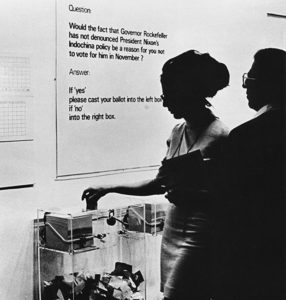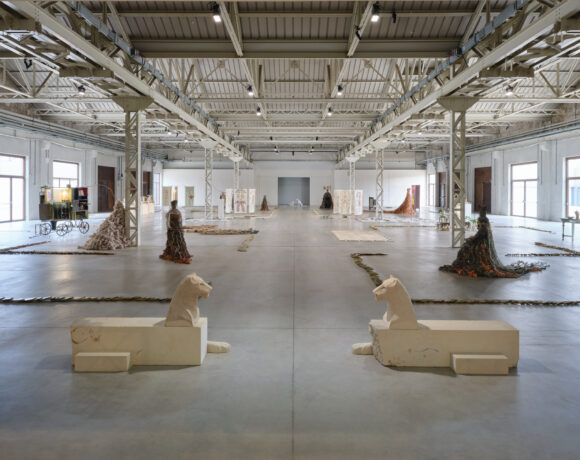On September 20, 1970, the exhibition Information ends at the Museum of Modern Art in New York. The group show, curated by Kynaston McShine, is proposed as an international reportage on the production of a new generation of artists in comparison with the mass media and recent technological innovations. However, the works of the over seventy artists involved are the expression of a present still in transit. The crisis generated by the Covid-19 emergency and the very central role played by the mass media in the production and use of contemporary art highlight the relevance of an exhibition such as Information. Fifty years after its closure, those reflections and questions still manifest their relevance.
Speed is one of the focal themes of the New York exhibition. As highlighted by McShine in the catalog, conceived as a separate part of the exhibition, the formulation of new communication models, between the sixties and seventies, is the natural consequence of an unprecedented acceleration in the transmission of data. The television imagery leads to the affirmation of an immediate and incisive language. McShine points out how, since 1970, video art is starting to acquire more and more importance. In this sense, it is evident that media saturation has made speed a quality that is still essential for the information society today. However, the acceleration of communications and social media have also contributed to bringing the public closer to an artistic scenario often considered peripheral to the nerve centers of the Western contemporary art system. According to the Trinidadian-born curator, it is no longer necessary to live in Paris or New York to be an artist and the recent success of African and Asian art supports this position.
Interactivity is another central aspect of the exhibition. Hans Haacke in MoMA Poll asks visitors if they will vote for Rockefeller, a member of the museum’s board of directors, in the upcoming presidential elections, despite the failure to denounce the policies implemented by Nixon in Indochina. The artist has two transparent urns, each equipped with a device to count the cards delivered at the entrance of the museum. The active involvement of the public therefore becomes a necessary aspect for the activation of the work. New media art and social media art seem to pick up on this legacy. The participation of the public is fundamental in the creation of the work itself, increasingly canceling the previous subordination of the viewer to the demiurge artist.
In Information, the use of mass media is a necessary step for the broader re-discussion of the consolidated aesthetic and expressive canons of the early twentieth century. The ephemeral nature of the exhibited works accentuates the conceptual and experiential component. A work becomes an exchange of information, as art is by its very nature a form of communication and a means of comparison. The works that make up the exhibition path reduce their own objectivity, while some interventions, as in the case of Lucy Lippard, are limited to the catalog. In this regard, it would not be risky to combine works such as Christine Kozlov‘s telegram or images transmitted via telex by the Canadian collective N.E Thing Co. with the dozens of works created in recent years on Instagram, Twitch or Whatsapp. The recent inaugurations via social media of digital exhibitions and events seem instead to echo the works of George Brecht and Robert Barry, in which the physicality of the work consists only in the documentation of an unrealized event.
Reflections on the materiality of art lead Mcshine to question the future role of collecting. At the same time, the curator wonders how institutions will be able to integrate technology into their exhibition planning. The digitization of collections as well as digital curatorship are practices that are increasingly rooted in today’s museum concept. The opening of virtual exhibition spaces, without a physical location, such as the Universal Woman Museum or the Universal Museum of Art confirms the farsightedness of Mcshine’s considerations. Even the art market, thanks to the excess of supply over demand, is adapting to digitization with the birth of platforms, such as R.A.R.E or DADA NYC, dedicated to the sale of virtual works of art in cryptocurrencies and blockchain services.
As recently highlighted by Paola Antonelli, the social conflict and the huge changes taking place in contemporary everyday life show numerous similarities with the seventies. Information is the image of change, the beginning of a new perception of art and its spaces.
Info:
 The New York Graphic Workshop-Newspaper Originated, 1969
The New York Graphic Workshop-Newspaper Originated, 1969
 Hans Haacke, MoMA Poll, performance, 1970
Hans Haacke, MoMA Poll, performance, 1970
 Information, catalogue cover, 1970
Information, catalogue cover, 1970

Jacopo De Blasio (Rome, 1993) graduated with honors in art history from the “La Sapienza” University in Rome, currently assistant librarian at MAXXI in Rome. He was a collaborator of the artist Maria Dompè and cultural mediator at Palazzo delle Esposizioni. Independent curator, he mainly deals with the relationship between contemporary art and society.






NO COMMENT